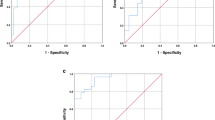Abstract
Objective
To identify the percentage of body fat mass (FM) that would define obesity among Sri Lankan children.
Methods
A cross-sectional study was conducted among 5–15 y old children in the district of Colombo. FM was assessed using Bio Impedance Assay (BIA). After a 12 h overnight fast, blood was drawn for fasting blood glucose (FBS) and lipid profile. Oral-glucose-tolerance test (OGTT) was done along with 2 h random blood sugar (RBS). Metabolic syndrome (MetS) was diagnosed by a high waist circumference (WC) with ≥2 metabolic derangements [FBS/RBS, high density lipoprotein-cholesterol (HDL-C), triglyceride, and systolic and diastolic blood pressure (SBP/DBP)]. Receiver-Operator Characteristics (ROCs) were drawn to determine the best %FM that predicted MetS.
Results
Nine hundred twenty children were studied (547 boys). Fifteen (1.6 %) had MetS. Ninety five (10.3 %) had two and 16(1.7 %) had ≥3 metabolic derangements. MetS in boys was associated with %FM of 28.6 (sensitivity 1.000; specificity 0.870) and in girls 33.7 (sensitivity 0.875; specificity 0.808).
Conclusions
FM associated with adverse health outcomes in this population is comparable to other available data. A %FM of 28.6 % for boys and 33.7 % for girls would be acceptable cutoff limits.


Similar content being viewed by others
References
Lohman TG. The prevalence of obesity in children in the United States. In: Lohman TG, editor. Advances in Body Composition Assessment. Monogram 3. Human Kinetics: Champaign, IL; 1992. p. 79–89.
WHO. Obesity; preventing and managing the global epidemic. WHO Technical Report Series 894, Geneva: WHO. 2000.
McCarthy HD, Cole TJ, Fry T, Jebb SA, Prentice AM. Body fat reference curves for children. Int J Obes. 2006;30:598–602.
Dwyer T, Blizzard CL. Defining obesity in children by biological endpoint rather than population distribution. Int J Obes Relat Metab Disord. 1996;20:472–80.
Williams DP, Going SB, Lohman TG. Body fatness and risk for elevated blood pressure, total cholesterol and serum lipoprotein ratios in children and adolescents. Am J Public Health. 1992;82:358–63.
Zimmet P, Alberti KGMM, Kaufman F, Tajima N, Silink M, Arslanian S. The metabolic syndrome in children and adolescents – an IDF consensus report. Pediatr Diabetes. 2007;8:299–306.
Wickramasinghe VP, Lamabadusuriya SP, Cleghorn GJ, Davies PS. Validity of currently used cut off values of body mass index as a measure of obesity in Sri Lankan children. Ceylon Med J. 2009;54:114–9.
Wickramasinghe VP, Lamabadusuriya SP, Cleghorn GJ, Davies PSW. Assessment of body composition in Sri Lankan children: validation of a bioelectrical impedance prediction equation. Eur J Clin Nutr. 2008;62:1170–7.
Wickramasinghe VP, Lamabadusuriya SP, Cleghorn GJ, Davies PSW. Development of height-weight based equation for assessment of body composition in Sri Lankan children. Indian J Pediatr. 2010;77:155–60.
McCarthy HD, Jarrett KV, Crawley HF. The development of waist circumference percentiles in British children aged 5.0–16.9 yrs. Eur J Clin Nutr. 2001;55:902–7.
Jackson LV, Thalanga NKS, Cole TJ. Blood pressure centriles for great Britain. Arch Dis Child. 2007;29:298–303.
Lohman TG. Assessment of body composition in children. Pediatr Exerc Sci. 1989;1:19–30.
Cole TJ, Bellizzi MC, Flegal KM, Dietz WH. Establishing a standard definition for childhood overweight and obesity worldwide: international survey. BMJ. 2000;320:1240–5.
Morris NM, Udry JR. Validation of a self-administered instrument to assess stage of adolescent development. J Youth Adolesc. 1980;9:271–80.
Freedman DS, Sirinivasan SR, Harsha DW, Webber LS, Berenson GS. Relation of body patterning to lipid and lipoprotein concentrations in children and adolescents: the Bogalusa heart study. Am J Clin Nutr. 1989;50:930–9.
Aristinuno GG, Foster JA, Voors AW, Sirinivasan SR, Berenson GS. Influence of persistent obesity in children on cardiovascular risk factors: the Bogalusa heart study. Circulation. 1984;69:895–904.
Voors AW, Harsha DW, Webber LS, Radhakrishnamurthy B, Srirnivasan SR, Berenson GS. Clustering of anthropometric parameters, glucose tolerance and serum lipids in children with high and low β– and pre β- lipoprotein in children: the Bogalusa heart study. Arteriosclerosis. 1982;2:346–55.
Lee K, Lee S, Kim SY, Kim SJ, Kim YJ. Percent body fat cutoff values for classifying overweight and obesity recommended by the international obesity task force (IOTF) in Korean children. Asia Pac J Clin Nutr. 2007;16:649–55.
Deurenberg P, Yap M, van Staveren WA. Body mass index and percent body fat: a meta analysis among different ethnic groups. Int J Obes. 1998;22:1164–71.
Duncan JS, Schofield G, Duncan EK, Rush EC. Classifying childhood obesity in a multiethnic population: comparisons among five major ethnic groups. O27 Abstract. Int J Body Comp Res. 2005;3:89.
Acknowledgments
The authors are grateful to all children and their parents for participating in this study. Also they are grateful to Ms. Amara S de S Wijerathna and Ms. A. U. A. Gunawardhana of the Reproductive Biology Laboratory, Department of Obstetrics and Gynaecology and Mr. S.D.D. Dissanayake of the Department of Paediatrics, University of Colombo in analyzing the blood samples.
Author information
Authors and Affiliations
Corresponding author
Ethics declarations
Contributions
VPW: Conceived, designed, carried out the study, analysed the data and wrote the manuscript; CA: Designed the study, analysed the data and wrote the manuscript; PB: Designed, carried out the study and wrote the manuscript; MA, SK, PD and BSD: Carried out the study, analysed the data and wrote the manuscript. VPW will act as guarantor for the paper.
Conflict of Interest
None.
Source of Funding
This study was carried out through an educational grant from Anchor Institute, to University of Colombo.
Rights and permissions
About this article
Cite this article
Wickramasinghe, V.P., Arambepola, C., Bandara, P. et al. Defining Obesity Using a Biological End Point in Sri Lankan Children. Indian J Pediatr 84, 117–123 (2017). https://doi.org/10.1007/s12098-016-2191-2
Received:
Accepted:
Published:
Issue Date:
DOI: https://doi.org/10.1007/s12098-016-2191-2




